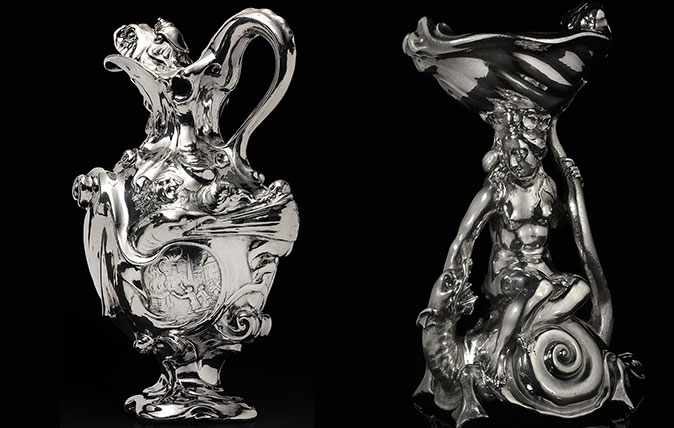In Focus: Two silver pieces by the genius who made ‘solid objects seemingly created from liquid itself’
Huon Mallalieu pays tribute to the work of Adam van Vianen, a 16th century Dutch silversmith whose work is still yet to be surpassed – with only his brother and his son coming close.


One of the most influential, but least known, European decorative developments is the auricular style, so called because its whorls and swirls resemble a human ear or, not coincidentally, the ear-bone of the whale. It emerged from the graphic designs of late Mannerist artists and first appeared in print in the 1598 edition of a German ornament book by Wendel Dietterlin.
Although later used on picture frames and furniture, its most important manifestation was the work of the silversmithing van Vianen brothers. The high reputations of Adam (1568–1627) and Paulus (1570–1613) are in part due to the fact that they were among the first to sign their work, but more to its extraordinary quality.
'A solid, water-bearing vessel seemingly created from liquid itself'
Adam seems to have remained in their native Utrecht, but Paulus travelled in France, Italy and Germany before spending his final decade in Prague, at the court of the great art patron Emperor Rudolph II. Evidently, the brothers stayed in contact, as both began to develop auricular forms in about 1600.
The admiration of fellow professionals is demonstrated by a covered ewer in the Rijks-museum, almost certainly commissioned from Adam by the Amsterdam silversmiths’ guild in memory of Paulus, despite neither being members nor living in the city.
This ewer, which seems almost to melt like a wax candle, appears as a exemplar of curiosity in at least 20 Dutch Golden Age still lifes. The auricular style was an ingredient in 18th-century Rococo and an influence on Art Nouveau in the 19th.
As well as ewers, chased dishes and salt cellars on figural supports, Adam van Vianen made a number of small, more Mannerist plaquettes, of which at least three survivors show St Paul’s Damascene conversion. I discussed one of them in Country Life couple of years ago when it had sold for £218,500 at Christie’s in London. It had been given a detachable mount and a fixed frilly rim in the 19th century, which may have kept the price down.
Before that, the only van Vianen piece that I remember on the open market was by Adam’s son Christian, who worked in England for Charles I and after the Restoration. That was an inkstand that sold for £78,000 in 1970 at Christie’s, where, in 1893, it had made £446 8s – a very considerable price.
Exquisite houses, the beauty of Nature, and how to get the most from your life, straight to your inbox.
Now, two pieces by Adam have come up for sale within four months, the first at Christie’s New York and the second in London at Sotheby’s.

The first, and more important, was a 9in-high baluster-shaped ewer dated 1619, which was chased in high relief with grotesque marine creatures and set with medallions telling the dramatic legend of Marcus Curtius, who sacrificed himself to preserve the Roman Republic.
Rather than being cast, it was fashioned from a single sheet of very pure silver; as Christie’s cataloguer wrote: ‘To Adam, silver was an almost fluid material. His skill in the art of chasing enabled him to create the ultimate artifice: a solid, water-bearing vessel seemingly created from liquid itself.’
It was the only auricular ewer by Adam known to be in private hands and is currently to be seen in the van Vianen show at the Rijksmuseum until September 16. It sold for $5.375 million (£4,147,001).
The Sotheby’s lot was a 7¾in-high salt modelled as the sea nymph Galatea, which had been in the Rothschild family to 1937 and latterly in a Dutch private collection. It sold comfortably above estimate, for £1,030,000.

Country Life is unlike any other magazine: the only glossy weekly on the newsstand and the only magazine that has been guest-edited by His Majesty The King not once, but twice. It is a celebration of modern rural life and all its diverse joys and pleasures — that was first published in Queen Victoria's Diamond Jubilee year. Our eclectic mixture of witty and informative content — from the most up-to-date property news and commentary and a coveted glimpse inside some of the UK's best houses and gardens, to gardening, the arts and interior design, written by experts in their field — still cannot be found in print or online, anywhere else.
